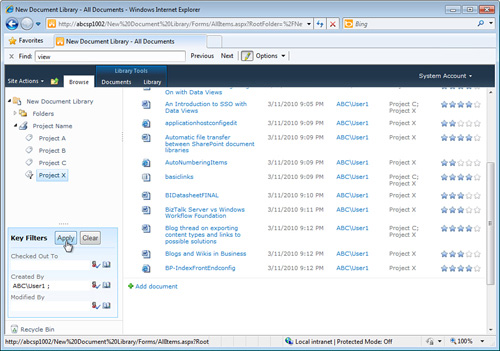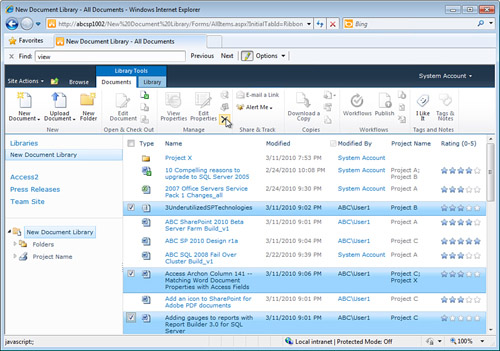Empowering Users Through SharePoint 2010 Libraries
Many users wonder what the difference is between simply continuing to store their files in a file share on their network, keeping them on their local hard drives to make sure they are close at hand, or using their email in boxes as storage and management tools. They also want to understand the differences in level of effort required to use the SharePoint tools, and get an inkling of the benefits they and their organization will see after investing in the new technologies presented by the SharePoint 2010 product line.
SharePoint 2010 document libraries offer a variety of features that have proven to be useful to a wide range of users and projects and that empower the site administrators to customize the storage and collaborative features of the library and enhance user productivity. Advantages provided by a SharePoint document library include the following:
• The administrator of a document library has a great deal of control over who can add, modify, and delete documents, or just read them, which often is not the case if a file share on the network is being used. Therefore, a departmental manager can easily control the set of users who can read or modify documents under her control without filing a help desk ticket or needing special privileges on the network. Permissions can be modified for an individual document or folder within the document library, as well.
• Versioning can be turned on for a document library that keeps a complete copy of previous versions of the document for reference or recovery purposes. Both major and minor versions can be tracked, encouraging a more formal process of determining when a document is ready for general use or still in the development cycle.
• Alerts can be set on a document within the library, a folder in the library, or for the entire library so that the user receives an email notification if a document is modified, added, or deleted and can set other criteria, such as weekly summaries to minimize in-box clutter.
• Documents can be checked out, with the name of the person who has the document checked out listed in the library, so that other users can’t modify the document. Checking out can be required before a user can edit a document to further ensure best practices for document editing.
• A template can be stored in the document library that can be used to create a new document that is stored in the library by default. So, for example, a document library designed to hold technical specifications documents can provide a Word template document with the latest format, layout, and sections in it.
• Metadata can be added to a document library that enables users to better describe what type of document it is based on company standards (for example, Proposal, Project Plan, Report, Procedure), which product it covers, who owns the document (as opposed to who last modified it), or pretty much any other kind of textual or numerical information. SharePoint 2010 adds more control over default settings in a document library and allows ratings to be added. Figure 19.1 shows ratings in the far-right column.
Figure 19.1. SharePoint 2010 document library with metadata navigation tools and Ratings column.

• Views can be created that group documents by certain criteria, sort them by any of the columns in the library, or only display documents that meet certain criteria. For example, the view from the home page may well be different from the view within the document library to minimize the amount of space taken up on the home page and to only show the last ten documents modified, for example.
• The ability to search within the library for text contained within the document, a feature often not available on a corporate network. In addition, the ability to search the metadata associated with a document makes it easier for users to find the desired document more quickly. Entering a search term in the search bar in a SharePoint 2010 document library defaults to the This List scope, and the user can then expand and fine tune the search from the search results page.
• If the organization decides on certain standards for the customization of a document library, it can create a template that can include the content if desired and can be used in other sites. This helps promote standards for document library design and features supported.
• SharePoint 2010 libraries offer additional features such as the I Like It tag, and additional tags and notes can be added to documents by users to encourage comments and input from the users.
• Metadata navigation allows users of the library to easily click a few items and filter what appears in the view. Figure 19.1 shows an example of how a user chooses to view only documents with metadata tags of Project X for Project Name, and that were modified by User1. This feature is new to SharePoint 2010 and more intuitive and easy to use than the filters in SharePoint 2007, which had to be accessed at the top of the columns.
• Workflows can be created on-the-fly or predesigned for use within the document library to get feedback or approval, or more complex workflows can be designed by developers to start more complex processes that involve more complex actions and business logic. A Quick Step can be defined that appears on the Ribbon to allow one-click actions that are custom designed for the library users.
• Incremental changes in the document library such as the Ribbon interface, and the ability to check the document or documents you are working on, make it easier for administrators and end users to quickly come up to speed with the array of tools offered in the document library. Figure 19.2 shows the Ribbon interface, with the Documents tab active, and three documents selected, and the cursor hovering over the Delete button.
Figure 19.2. SharePoint 2010 document library with the Documents tab on the Ribbon visible, and several documents selected.

• The contents of the document library can be downloaded to SharePoint Workspace or the Outlook client so that it can be accessed when the user is offline.
• A two-stage recycle bin is available, to rescue users’ documents from the inevitable accidental deletions that occur.
Note
Mastering all of these features can be complex for the document library administrator as well as for the users. It is important to balance the complexity of the library and the number of features leveraged with the sophistication of the typical users of the library, and the type of content that will be stored in the document library. Better to “start simple” with a few metadata columns, the ratings column, versioning enabled, and standard workflows, than to overcomplicate the document library if users are brand new to SharePoint. On the other hand, if the document library users have been using SharePoint 2007 for several years, it can make sense to enable more complex features, such as complex metadata, document workspaces, and custom workflows.
Although a percentage of users of SharePoint document libraries may complain about learning yet a new software application, after a little training, they will quickly appreciate the features that make their working day more productive. For example, one immediate benefit of having versioning enabled is that only the latest version shows up in the document library. This means that users don’t have to spend extra time deciphering complex filenames or looking at modification dates to make sure they are in fact editing the latest version. The ability to check out a document makes it easy for a user to “reserve” a document that he doesn’t want anyone else modifying and knows he needs to work on over the weekend. By allowing users to rate documents, the document library takes on an added dimension of social interaction, further differentiating best-of-breed documents from mediocre and worst-of-breed documents.
Administrators will quickly come to appreciate the ability to add new columns of information to a document library that help them manage their documents, and help their users quickly find the exact document they are looking for, to create customized views, and leverage granular search, and metadata navigation. For example, by simply adding a column called Client, a sales manager can make it clear which client a document was created for. In addition, by providing a column titled Value of Opportunity, the total dollar amount of the proposal can easily be seen without opening the document. And if the Ratings column is enabled, an administrator can see over time which documents are the most popular and well received, and learn about the needs of the users, as well as archive the less-useful documents if applicable.
Note
The inclusion of the Ribbon interface in SharePoint 2010 is more than just a cosmetic change. It dramatically reduces the learning curve for new and existing users and administrators alike. The large number of tools available to users and admins are now available in a tabbed interface in one place, rather than spread out among different drop-down menus, and the use of visually relevant icons truly makes a difference and reduces the learning process.
